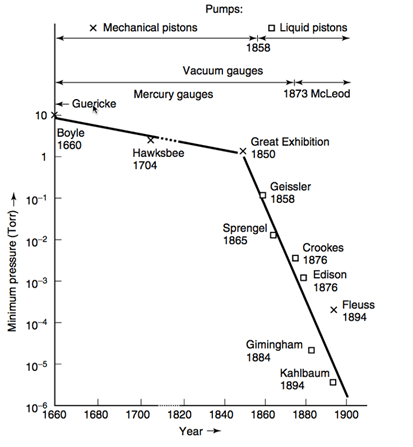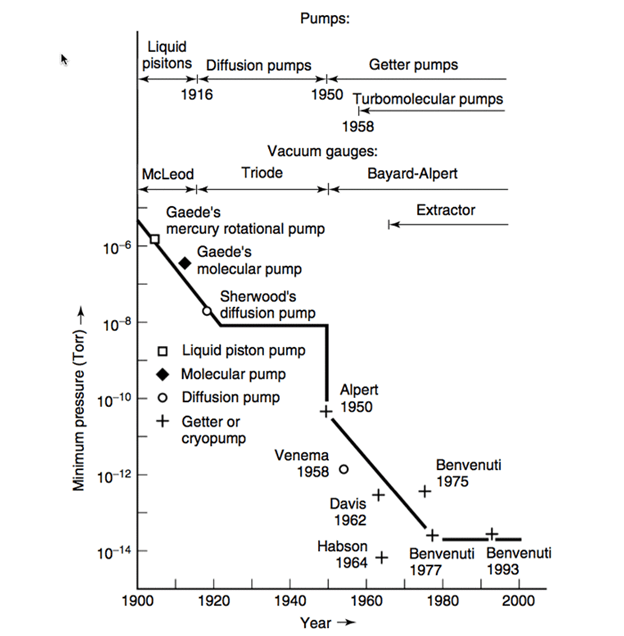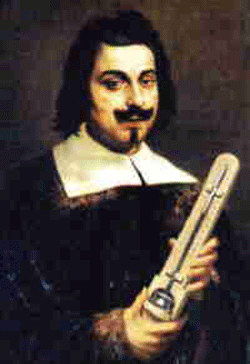A Brief History of Vacuum Technology
Early History
The history of vacuum technology is a fascinating one. It seems to have begun in ancient Greece when the philosopher Democritus (circa 460 to 375 B.C.) proposed that the world was made up of tiny particles that he calledatoms (atomos, Greek: undividable). Democritus’ belief was that empty space (in other words, in modern terminology, a vacuum) existed between the atoms, which moved according to the general laws of mechanics. Democritus, together with his teacher Leucippus, may indeed be considered as the inventors of the concept of a vacuum and our modern view of physics is heavily influenced by their ideas.

However, it was the thinking of Aristotle (384 – 322 B.C.) that dominated the scientific community up until the 16th century. Aristotle denied the existence of a vacuum as it conflicted with the idea that the universe was comprised of countless individual particles. According to Aristotle, nature consisted of the four basic elements namely water, earth, air, and fire. In fact, the word vacuum comes to us from the Latin word “vacuus” meaning empty or “vacare” meaning “to be empty”.
Medieval Times
Up until 1300 A.D., phrases such as “horror vacui” (i.e., nature abhors a vacuum) were in common use and early scientific investigators such as Bruno (1548 – 1600 A.D.) were burned at the stake for their beliefs! Renaissance writers such as Descartes (1596 – 1650) as well as the Catholic Church stubbornly refused to acknowledge the very existence of a vacuum. Eventually, however, scientific progress on the subject could not be stymied and by 1600 the possibility or impossibility of a space without matter was a hotly debated issue within the scientific and philosophical community of Italy, and later, France and Germany.
In 1613, Galileo Galilei (1564 – 1642) proposed and subsequently proved that air had both weight and density. As a result, for the first time, air was considered a substance with a specific weight. This brought about the further assumption that air could in some way, be removed from a given space.
Galilei’s experiment led to one by Gasparo Berti (1600 – 1643) in 1640, and subsequently Evangelista Torricelli (1608 – 1647) in 1644. Torricelli used a glass tube about 1 m in length, and filled it with mercury. He sealed the open end of the tube with a fingertip and then flipped the sealed end of the tube facing downwards. He then submerged the tube in a mercury reservoir and removed his finger, allowing the mercury inside the tube to be in contact with the reservoir. The column of mercury in the tube sank to 76 cm, measured from the liquid surface of the reservoir. The space left in the glass tube above the mercury was in fact a vacuum. The level of mercury was independent of the volume above. His work, known as the Torricelliexperiment, was the very first successful attempt to produce a vacuum, convincing the scientific community of its existence. The Torricelli experiment is said to be one of the key scientific experiments of natural science. An earlier attempt of this experiment by Gasparo Berti using water was less successful.
In 1646, Blaise Pascal (1623 – 1662) repeated the Torricelli experiment trying other types of liquids. His findings led to the understanding that the maximum height was inversely proportional to the density of the liquid used. Pascal had a discussion with philosopher Descartes in 1647, in which they developed the idea of air-pressure measurements at different altitudes using a Torricellian tube.
Around 1650, Otto von Guericke (1602 – 1686), one of the leading “vacuist”s of his day (that is, a person claiming vacuum is possible) produced a vacuum in a specially constructed sphere. After evacuating the sphere and leaving it untouched for several days, air started somehow seeping into the sphere. Investigation into the problem led to the discovery that air was seeping into the sphere, mainly through the pistons of the pump and seals of the valves. To combat this phenomenon, Guericke constructed a new pump whose parts were sealed by water, an idea used even to this day, but with oil instead of water.
Further scientific experiments were performed as well during the early days of vacuum. Christiaan Huygens (1629-1695) proved that the free fall speed of a feather in a vacuum is exactly equal to that of a piece of lead. Robert Boyle(1627 – 1691) found that the product of volume and pressure was constant.Guillaume Amontons (1663 – 1705) in France showed that this constant is temperature dependent.
Although early scientists made several advances in vacuum, there was still no clear definition of a vacuum. Up until 1874, the Torricellian tube was the only instrument available for vacuum measurement, being limited to about 0.5 mm Hg (67 Pa). By the end of the medieval period, the Aristotelian philosophy (that vacuum did not exist) was no longer accepted.
The Age of Enlightenment
During a fifty year span from 1850 – 1900, activity in the development of vacuum technology was driven first, by the needs of scientific research and later by the demands of the incandescent lamp industry. During this period the attainable pressure was reduced by six decades and equipment became increasingly sophisticated. For example, advancements in seal technology and the necessity to thoroughly outgas vacuum equipment became readily apparent. However, it wasn’t until the development of the gas kinetic theory by Pieter von Clausing (1898 – 1994), James Clerk Maxwell (1831 – 1879) and Ludwig Boltzmann (1844 – 1906), as well as the invention of the gauge by Herbert McLeod (1841–1923) in 1874, that vacuum indeed was considered a measurable physical quantity.
In 1879, Thomas Alva Edison (1847 – 1931) began using vacuum technology to help produce his first lamps. Edison utilized a modified mercury drop pump when experimenting with his early inventions and finally on his first production of electric lamps where a pressure of less than 10-3 Torr was necessary for the chemical gettering of water.
The 20th Century

At the beginning of the 20th century, the use of vacuum as an industrial process was just emerging, driven by the invention of the electric light. The introduction of the radio and of television, both of which depended on vacuum tubes, helped expand the demand for vacuum. Metallurgical advantages of processing in a vacuum were soon widely recognized. The first industrial order on record for vacuum furnaces was in 1929 by Raytheon Corporation.
Two individuals had a profound impact on the industry in this period, namely Wolfgang Gaede (1878-1945) in Germany and Irving Langmuir (1881-1957) in the United States. Gaede invented the rotary mercury pump and Langmuir worked on gas-filled incandescent lamps. At the dawn of the nuclear age in the 1950’s the development of even more sophisticated vacuum applications followed. These developments in vacuum science and technology include high energy particle physics, atomic energy, isotope separation, optical and microelectronic coatings, heat sensitive fluids (e.g. photographic emulsions) and vacuum metallurgy (e.g. melting).
The Modern Era
Today, vacuum applications in industry spans a wide gambit, from adherence devices (e.g. suction pads) to the deposition of electronic circuits on silicon microchips. The vacuum requirements are as varied as the particular processes using vacuums. In the vacuum range of 1 Torr to near atmosphere, applications can range from mechanical handling, oil degassing, gas sampling, concentration of aqueous solutions, distillation, filtration, impregnation of electrical components, steel steam degassing and vacuum packing and forming.
The use of lower pressures, those in the 10-4 to 10-5 Torr range are used to improve many metallurgical processes, such as sintering, heat treatment, casting, melting, and brazing. Other chemical processes that also need this range of vacuum include vacuum distillation and freeze-drying. The process of freeze-drying is used extensively by pharmaceutical companies in preparation of vaccines and antibiotics, as well as storing of skin and blood plasma.
Applications in the process range of 10-6 Torr and below are used for thin-film coating, cryogenics (low-temperature range) and electrical insulation. The production of lamps; television picture tubes, X-ray tubes; optical, decorative, and electrical thin-film coatings; as well as mass spectrometer leak detectors all utilize pressures as low as 10-6 Torr.
Thin-film coating technology, for example, involves the vaporization of pure metal or compounds under high vacuum from a source material onto a substrate (base material). The base material is often glass, ceramic, or silica for electrical coatings; plastic for decorative coatings; or glass for optical coatings.
Lower vacuum ranges down to 10-9 Torr are used for research, laboratory experiments and even more sophisticated vacuum applications such as thermonuclear energy conversion experiments, microwave tubes, field ion microscopes, field emission microscopes, storage rings for particle accelerators, specialized space simulator experiments, and clean-surface studies.
Today, the lowest achieved vacuum level (on Earth) is 10-13 Torr and scientists continue to explore the field of vacuum technology and vacuum science, and make innovative discoveries.
Author: Dan Herring, The Herring Group, Inc.
References
- The History of Vacuum Science and Vacuum Technology: Pioneers of the 20th Century, Paul A. Redhead (Ed.), John Wiley & Sons, 1994.
- A Short History of Vacuum Terminology and Technology, McAllister Technical Services (www.mcallister.com)
- Redhead, P. A., History of Vacuum Devices, National Research Council, Ottawa Canada.
- Dylla, H. F., Introduction to Vacuum Science and Technology, CERN Conference Presentation, May 2006.
- Ormrod, Stephen and Nigel Schofield, Current and future trends in vacuum process technology, Solid State Technology, 2009.

